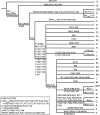New binary polymorphisms reshape and increase resolution of the human Y chromosomal haplogroup tree
- PMID: 18385274
- PMCID: PMC2336805
- DOI: 10.1101/gr.7172008
New binary polymorphisms reshape and increase resolution of the human Y chromosomal haplogroup tree
Abstract
Markers on the non-recombining portion of the human Y chromosome continue to have applications in many fields including evolutionary biology, forensics, medical genetics, and genealogical reconstruction. In 2002, the Y Chromosome Consortium published a single parsimony tree showing the relationships among 153 haplogroups based on 243 binary markers and devised a standardized nomenclature system to name lineages nested within this tree. Here we present an extensively revised Y chromosome tree containing 311 distinct haplogroups, including two new major haplogroups (S and T), and incorporating approximately 600 binary markers. We describe major changes in the topology of the parsimony tree and provide names for new and rearranged lineages within the tree following the rules presented by the Y Chromosome Consortium in 2002. Several changes in the tree topology have important implications for studies of human ancestry. We also present demography-independent age estimates for 11 of the major clades in the new Y chromosome tree.
Figures

References
-
- Adams S.M., King T.E., Bosch E., Jobling M.A., King T.E., Bosch E., Jobling M.A., Bosch E., Jobling M.A., Jobling M.A. The case of the unreliable SNP: Recurrent back-mutation of Y-chromosomal marker P25 through gene conversion. Forensic Sci. Int. 2006;159:14–20. - PubMed
-
- Behar D.M., Garrigan D., Kaplan M.E., Mobasher Z., Rosengarten D., Karafet T.M., Quintana-Murci L., Ostrer H., Skorecki K., Hammer M.F., Garrigan D., Kaplan M.E., Mobasher Z., Rosengarten D., Karafet T.M., Quintana-Murci L., Ostrer H., Skorecki K., Hammer M.F., Kaplan M.E., Mobasher Z., Rosengarten D., Karafet T.M., Quintana-Murci L., Ostrer H., Skorecki K., Hammer M.F., Mobasher Z., Rosengarten D., Karafet T.M., Quintana-Murci L., Ostrer H., Skorecki K., Hammer M.F., Rosengarten D., Karafet T.M., Quintana-Murci L., Ostrer H., Skorecki K., Hammer M.F., Karafet T.M., Quintana-Murci L., Ostrer H., Skorecki K., Hammer M.F., Quintana-Murci L., Ostrer H., Skorecki K., Hammer M.F., Ostrer H., Skorecki K., Hammer M.F., Skorecki K., Hammer M.F., Hammer M.F. Contrasting patterns of Y chromosome variation in Ashkenazi Jewish and host non-Jewish European populations. Hum. Genet. 2004;114:354–365. - PubMed
-
- Calafell F., Comas D., Bertranpetit J., Comas D., Bertranpetit J., Bertranpetit J. Why names? Genome Res. 2002;12:219–221. - PubMed
-
- Cann H.M., de Toma C., Cazes L., Legrand M.F., Morel V., Piouffre L., Bodmer J., Bodmer W.F., Bonne-Tamir B., Cambon-Thomsen A., de Toma C., Cazes L., Legrand M.F., Morel V., Piouffre L., Bodmer J., Bodmer W.F., Bonne-Tamir B., Cambon-Thomsen A., Cazes L., Legrand M.F., Morel V., Piouffre L., Bodmer J., Bodmer W.F., Bonne-Tamir B., Cambon-Thomsen A., Legrand M.F., Morel V., Piouffre L., Bodmer J., Bodmer W.F., Bonne-Tamir B., Cambon-Thomsen A., Morel V., Piouffre L., Bodmer J., Bodmer W.F., Bonne-Tamir B., Cambon-Thomsen A., Piouffre L., Bodmer J., Bodmer W.F., Bonne-Tamir B., Cambon-Thomsen A., Bodmer J., Bodmer W.F., Bonne-Tamir B., Cambon-Thomsen A., Bodmer W.F., Bonne-Tamir B., Cambon-Thomsen A., Bonne-Tamir B., Cambon-Thomsen A., Cambon-Thomsen A., et al. A human genome diversity cell line panel. Science. 2002;296:261–262. - PubMed
-
- Capelli C., Wilson J.F., Richards M., Stumpf M.P., Gratrix F., Oppenheimer S., Underhill P., Pascali V.L., Ko T.M., Goldstein D.B., Wilson J.F., Richards M., Stumpf M.P., Gratrix F., Oppenheimer S., Underhill P., Pascali V.L., Ko T.M., Goldstein D.B., Richards M., Stumpf M.P., Gratrix F., Oppenheimer S., Underhill P., Pascali V.L., Ko T.M., Goldstein D.B., Stumpf M.P., Gratrix F., Oppenheimer S., Underhill P., Pascali V.L., Ko T.M., Goldstein D.B., Gratrix F., Oppenheimer S., Underhill P., Pascali V.L., Ko T.M., Goldstein D.B., Oppenheimer S., Underhill P., Pascali V.L., Ko T.M., Goldstein D.B., Underhill P., Pascali V.L., Ko T.M., Goldstein D.B., Pascali V.L., Ko T.M., Goldstein D.B., Ko T.M., Goldstein D.B., Goldstein D.B. A predominantly indigenous paternal heritage for the Austronesian-speaking peoples of insular Southeast Asia and Oceania. Am. J. Hum. Genet. 2001;68:432–443. - PMC - PubMed
Publication types
MeSH terms
Substances
LinkOut - more resources
Full Text Sources
Other Literature Sources
